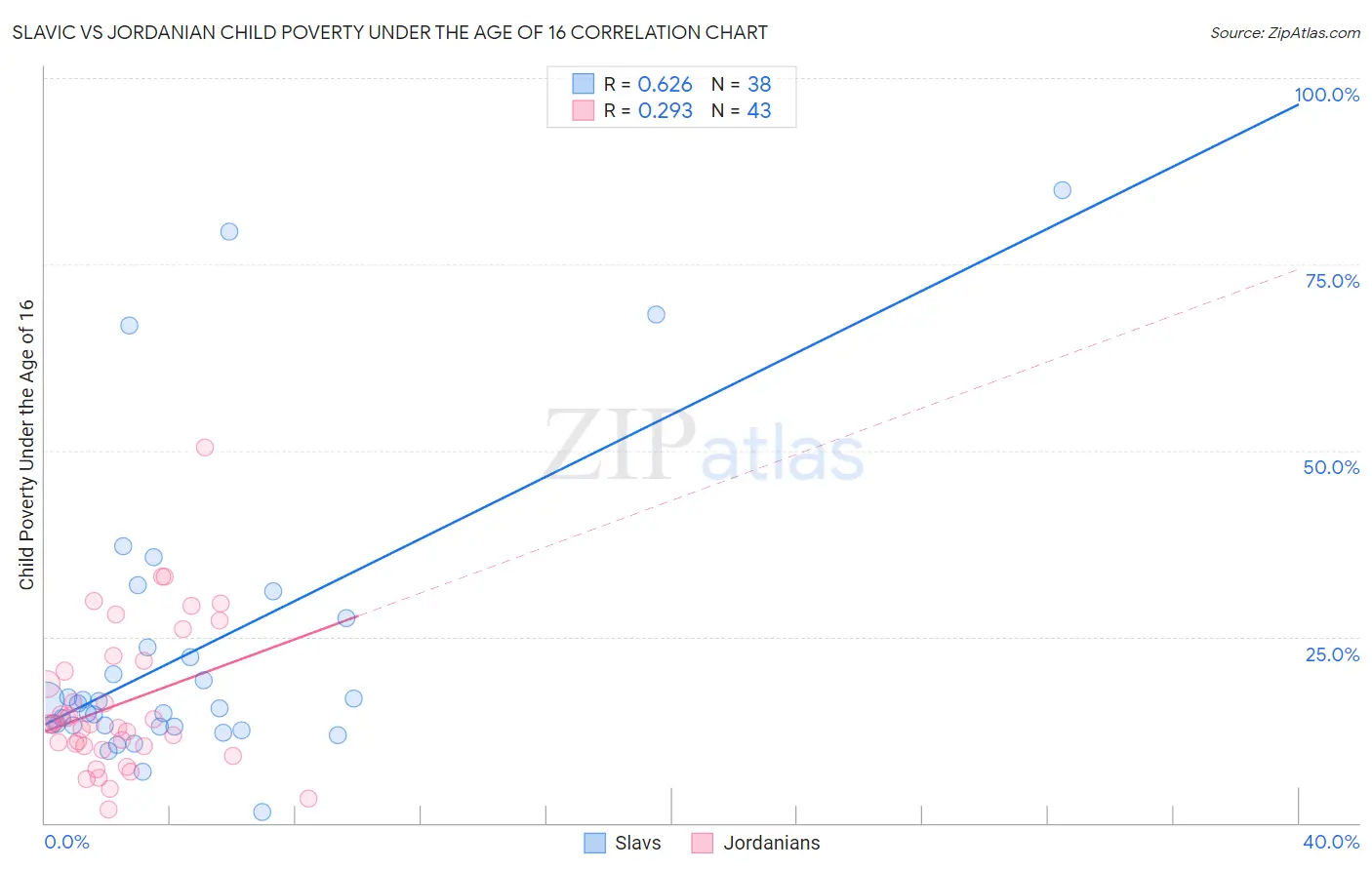Slavic vs Jordanian Child Poverty Under the Age of 16
COMPARE
Slavic
Jordanian
Child Poverty Under the Age of 16
Child Poverty Under the Age of 16 Comparison
Slavs
Jordanians
15.4%
CHILD POVERTY UNDER THE AGE OF 16
84.2/ 100
METRIC RATING
141st/ 347
METRIC RANK
14.8%
CHILD POVERTY UNDER THE AGE OF 16
94.2/ 100
METRIC RATING
108th/ 347
METRIC RANK
Slavic vs Jordanian Child Poverty Under the Age of 16 Correlation Chart
The statistical analysis conducted on geographies consisting of 268,968,300 people shows a significant positive correlation between the proportion of Slavs and poverty level among children under the age of 16 in the United States with a correlation coefficient (R) of 0.626 and weighted average of 15.4%. Similarly, the statistical analysis conducted on geographies consisting of 165,957,171 people shows a weak positive correlation between the proportion of Jordanians and poverty level among children under the age of 16 in the United States with a correlation coefficient (R) of 0.293 and weighted average of 14.8%, a difference of 3.6%.

Child Poverty Under the Age of 16 Correlation Summary
| Measurement | Slavic | Jordanian |
| Minimum | 1.5% | 1.8% |
| Maximum | 85.0% | 50.5% |
| Range | 83.5% | 48.6% |
| Mean | 23.0% | 16.0% |
| Median | 15.7% | 13.3% |
| Interquartile 25% (IQ1) | 13.0% | 10.3% |
| Interquartile 75% (IQ3) | 23.5% | 21.8% |
| Interquartile Range (IQR) | 10.6% | 11.5% |
| Standard Deviation (Sample) | 19.7% | 9.8% |
| Standard Deviation (Population) | 19.4% | 9.7% |
Similar Demographics by Child Poverty Under the Age of 16
Demographics Similar to Slavs by Child Poverty Under the Age of 16
In terms of child poverty under the age of 16, the demographic groups most similar to Slavs are Brazilian (15.4%, a difference of 0.34%), Icelander (15.4%, a difference of 0.41%), Immigrants from Hungary (15.5%, a difference of 0.53%), Immigrants from Peru (15.5%, a difference of 0.58%), and Slovak (15.5%, a difference of 0.62%).
| Demographics | Rating | Rank | Child Poverty Under the Age of 16 |
| Native Hawaiians | 88.7 /100 | #134 | Excellent 15.2% |
| Albanians | 88.6 /100 | #135 | Excellent 15.2% |
| Immigrants | Spain | 87.3 /100 | #136 | Excellent 15.3% |
| Peruvians | 87.2 /100 | #137 | Excellent 15.3% |
| Welsh | 87.2 /100 | #138 | Excellent 15.3% |
| Immigrants | Vietnam | 87.1 /100 | #139 | Excellent 15.3% |
| New Zealanders | 86.9 /100 | #140 | Excellent 15.3% |
| Slavs | 84.2 /100 | #141 | Excellent 15.4% |
| Brazilians | 82.8 /100 | #142 | Excellent 15.4% |
| Icelanders | 82.5 /100 | #143 | Excellent 15.4% |
| Immigrants | Hungary | 81.9 /100 | #144 | Excellent 15.5% |
| Immigrants | Peru | 81.7 /100 | #145 | Excellent 15.5% |
| Slovaks | 81.4 /100 | #146 | Excellent 15.5% |
| Immigrants | Kuwait | 80.5 /100 | #147 | Excellent 15.5% |
| Puget Sound Salish | 80.3 /100 | #148 | Excellent 15.5% |
Demographics Similar to Jordanians by Child Poverty Under the Age of 16
In terms of child poverty under the age of 16, the demographic groups most similar to Jordanians are Tlingit-Haida (14.9%, a difference of 0.070%), Chilean (14.8%, a difference of 0.090%), Serbian (14.8%, a difference of 0.15%), Basque (14.8%, a difference of 0.28%), and Immigrants from England (14.8%, a difference of 0.39%).
| Demographics | Rating | Rank | Child Poverty Under the Age of 16 |
| Immigrants | Switzerland | 95.1 /100 | #101 | Exceptional 14.8% |
| Romanians | 95.0 /100 | #102 | Exceptional 14.8% |
| Immigrants | Egypt | 94.9 /100 | #103 | Exceptional 14.8% |
| Immigrants | England | 94.8 /100 | #104 | Exceptional 14.8% |
| Basques | 94.7 /100 | #105 | Exceptional 14.8% |
| Serbians | 94.5 /100 | #106 | Exceptional 14.8% |
| Chileans | 94.4 /100 | #107 | Exceptional 14.8% |
| Jordanians | 94.2 /100 | #108 | Exceptional 14.8% |
| Tlingit-Haida | 94.1 /100 | #109 | Exceptional 14.9% |
| English | 93.5 /100 | #110 | Exceptional 14.9% |
| Immigrants | Denmark | 93.5 /100 | #111 | Exceptional 14.9% |
| Irish | 93.4 /100 | #112 | Exceptional 14.9% |
| Belgians | 93.3 /100 | #113 | Exceptional 14.9% |
| Sri Lankans | 93.2 /100 | #114 | Exceptional 14.9% |
| Immigrants | Ukraine | 93.1 /100 | #115 | Exceptional 14.9% |